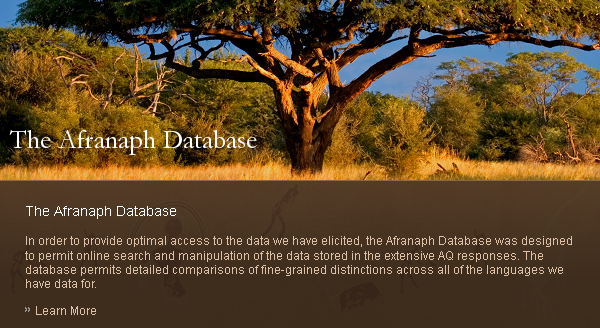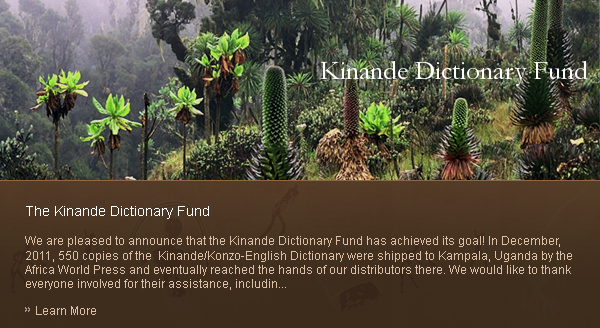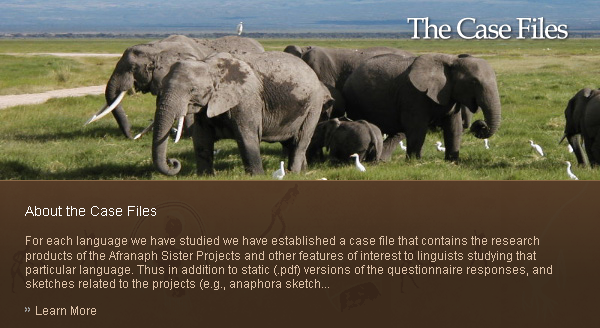About
The Multi-portal Design
For example, the Anaphora Portal includes the language and sentence entities that all the portals include, but also an entity called ‘anaphoric marker’. Anaphora Project researchers determine what the anaphoric markers are in a given language and what properties they have (according to our Database Property Attribution Guide). The Anaphora Portal includes search options that return sets of anaphoric markers based on their properties, in addition to searches that return sets of sentences or sets of languages. You can browse the database or use the search form to find languages, anaphoric markers or sentences of interest.
All of the portals have the same basic design, though the sets of analytic entities differ. At this writing, there are three portals: The Anaphora Portal, the Clausal Complementation Portal and the Generic Portal. The Generic Portal only permits searches for sentences and languages, but the browse page for any language will display all of the analytic entities that are otherwise unique to other portals. Anyone with an interest in languages for which we have data can search our basic sentence data using the Generic Portal with their own agenda in mind, ignoring any categorizations of the specific projects beyond our basic conventions of glossing and morpheme breakdown.
The Clausal Complementation portal has different analytic entities than the Anaphora Portal and thus permits searches that the other portals do not. Thus while research groups can organize data as they see fit, and design properties for entities that help them in their research, all of the sentence data collected for any project expands what is available in all the portals. For practical information about using the multi-portal design features in your research, go to About the Database
![]()
The main goal of the African Anaphora Project, the eldest of the Afranaph Sisters, is to develop rich descriptions of a wide range of African languages in order to serve the interests of linguistic research into the nature and distribution of anaphoric effects. Anaphoric readings, in the sense intended here, are those readings where one linguistic form, such as a pronoun, reflexive or reciprocal, refers back to a previously mentioned form in the sentence or in the discourse. It appears that every human language has at least some specialized forms that achieve such effects. This website explores those forms and effects for every African language that native speaker linguist consultants are willing to help us with. Although this project is informed specifically by the research goals of generative grammar, it is our intention to make the data we collect as accessible as possible to any linguist with an interest in these languages or more general issues in crosslinguistic comparison.
Within the history of generative grammar, the current state of understanding at any given time about the distribution of anaphoric effects has played an important role in stimulating theoretical innovations that have often not been confined to the empirical domain of anaphora. As early as the 1960s, it was observed that a significant range of anaphoric effects and interpretations are configurationally conditioned, and in that sense, are important clues and boundary conditions as to what version of syntactic theory and interpretation is most likely to be the correct one. Since the 1980s, variation in the patterns of anaphora found across the world’s languages has become a preoccupation for those interested in sifting universals and principled typologies from the welter of empirical patterns and this project is designed to explore fine details of patterns that have been undetected before, as well as patterns new to theoretical research.
More about the Anaphora Project
A basic premise of the research described in Safir (2004) and Safir (to appear) (= Technical Report #1 on this site) and now Safir (2012) (=Technical Report #4 on this site), is that the distributions of anaphoric forms in any given language are in competition to represent the range of possible anaphoric readings, so only by understanding the complete pattern in any given language can the interactions that determine the pattern be predicted. An earlier anaphora questionnaire that inspired the one used here was developed by Martin Everaert and Alexis Dimitriadis of the University of Utrecht in the early 2000s (with input from the PI), aimed at finding as many patterns as could be made to bear on issues in the theory of anaphora that were current at that time. The Anaphora Questionnaire (AQ) used in this Afranaph Sister Project is a revision and an extension of the Utrecht questionnaire designed to enhance the elicitation of exhaustive accounts of the distributions of anaphoric effects internal to each language that theories based on a variety of premises could use as a testing ground for both typological and universals-oriented theorizing.
The Afranaph Project began with an exploration of anaphoric patterns in the non-colonial languages of Africa in 2003. The empirical work of this project, while always its raison d’etre, frequently was delayed and backgrounded over the years as the technology, mode of operation, network and infrastructure that supports the modern Afranaph Project was being developed. The empirical and theoretical work of the Anaphora Project has gone on robustly in the shadows and the project director hopes that more analytic and theoretical work that has resulted from it will be reported on in the next few years.
What is currently visible of the anaphora research is mostly contained in the work published on our site. In addition to technical reports #1, #2 (Reauland and Schadler, 2011) and #4 and the abstracts to be found on the Afranaph Workshop page, several Anaphora Sketches have been completed, and though the early ones are indeed ‘sketchy’ (see the sketches for Yoruba, Urhobo, and Cinsenga, all from 2005), the later ones are somewhat more fleshed out (see the sketches for Ikalanga and Kinande from 2007). The most recent one is extensive and fine-grained (see the Lubukusu Anaphora Sketch from 2011). Much more work, both general essays and nascent anaphora sketches, remains in either extensive notes or incomplete manuscripts, and much more data in the form of incomplete AQRs, has yet to see the light of day. The PI hopes to provide a partial inventory of this work sometime in late 2012 or early 2013.
Afranaph Questionnaire in English [pdf] [doc] | et en Français [pdf] [doc]
![]()
It has often been claimed that overt preverbal subjects have A’ properties in null subject languages (henceforth NSLs) because “rich” subject agreement precludes lexical material from occupying the canonical subject position, Spec, TP (see Alexiadou & Anagnostopoulou 1998). Because the 400+ Bantu languages are NSLs, they are highly relevant to this hypothesis. We accordingly propose a thorough investigation of the syntax of Bantu subjects.
There has been some previous work claiming Bantu preverbal subjects exhibit A’ properties and hence are always topicalized or left-dislocated (see Baker 1996, 2003 and Schneider-Zioga 2007). But we find the arguments quite inconclusive: not enough languages are represented, not enough tests have been conducted, and the evidence provided is easily reinterpreted as arising from extraneous factors.
What is needed in our view is a very thorough questionnaire to gather data from a broad range of Bantu languages, first establishing the properties of left-dislocation and topicalization constructions in each language and then comparing these with the properties of preverbal subjects. We will then carefully compare them to subjects in other non-Bantu NSLs and in non-NSLs.
Those interested in serving as native-speaker linguist consultants for this project should begin by consulting the Properties of Subjects in Bantu Questionnaire (PSBQ), which can be viewed and downloaded below or on the Become a consultant page. Those who decide to participate should then follow the instructions on the Become a consultant page, where details concerning how to participate (and remuneration) are provided. If you do decide to become a consultant, be sure to send a consent form which can be downloaded on that page.
You can access the Properties of Subjects in Bantu Questionnaire (PSBQ) here: [pdf] [doc]
![]()
The main goal of the African Anaphora Project, the eldest of the Afranaph Sisters, is to develop rich descriptions of a wide range of African languages in order to serve the interests of linguistic research into the nature and distribution of anaphoric effects. Anaphoric readings, in the sense intended here, are those readings where one linguistic form, such as a pronoun, reflexive or reciprocal, refers back to a previously mentioned form in the sentence or in the discourse. It appears that every human language has at least some specialized forms that achieve such effects. This website explores those forms and effects for every African language that native speaker linguist consultants are willing to help us with. Although this project is informed specifically by the research goals of generative grammar, it is our intention to make the data we collect as accessible as possible to any linguist with an interest in these languages or more general issues in crosslinguistic comparison.
Within the history of generative grammar, the current state of understanding at any given time about the distribution of anaphoric effects has played an important role in stimulating theoretical innovations that have often not been confined to the empirical domain of anaphora. As early as the 1960s, it was observed that a significant range of anaphoric effects and interpretations are configurationally conditioned, and in that sense, are important clues and boundary conditions as to what version of syntactic theory and interpretation is most likely to be the correct one. Since the 1980s, variation in the patterns of anaphora found across the world’s languages has become a preoccupation for those interested in sifting universals and principled typologies from the welter of empirical patterns and this project is designed to explore fine details of patterns that have been undetected before, as well as patterns new to theoretical research.
More about the Anaphora Project
Afranaph Questionnaire in English [pdf] [doc] | et en Français [pdf] [doc]
The Clausal Complementation Questionnaire (CCQ) is designed to begin the exploration of the clausal inventories and selection-meaning relations that obtain in a given language. Insofar as we want to establish a baseline for comparison, the CCQ does not aim to explore a particular language type, but instead is designed to uncover empirical issues of interest that will then be followed up in subsequent work. Moreover, the CCQ is itself broken into two parts. The first part, CCQ-A, aims to identify a wide range of clause-taking predicates and complement types. The second part, CCQ-B (still in development, 01/15/2012) explores the internal syntax of complement clause types by varying parameters internal to those clauses. Part 2 may be less standardized than Part 1 given that the set of clause types to explore should be somewhat delimited by the answers to Part 1. The third part (CCQ-C), (also still in development, 01/15/2012) works to identify what meanings obtains for a given predicate when it is associated with a given complement. This is achieved by means of inference tests, i.e., what inferences is the speaker or the predicate-experiencer committed to when the two are associated.
Consultants participating in the Clausal Complementation and Selection Project should expect follow-up with a new questionnaire as part of their work that leads to full remuneration (estimated at this time around $400). For the CCSP project directors, the answers to CCQ-A are not sufficient for analytic purposes, so the value of the data provided depends significantly on continuing participation in the follow-up process. However, when the secondary queries are completed, remuneration for full participation will be released. After a certain period of time, failure of the project directors to provide follow-up queries will make consultants eligible for immediate remuneration for the work completed (estimated $200). Right now, we are feeling our way through the whole process, so we don’t have standard policies, but our goal is to protect both our project researchers and our consultants from wasted effort.
It is hoped that consultants participating in this project will become involved in collaborative work reporting the empirical findings in an analytic paper to be published in the case file for his or her language on the Afranaph website.
You can access the Clausal Complementation and Selection Questionnaire here: [pdf] [doc]






